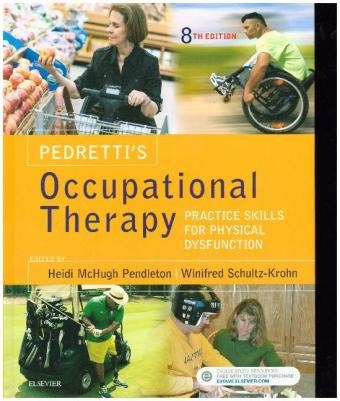
Pedretti's Occupational Therapy
Mosby (Verlag)
978-0-323-33927-8 (ISBN)
- Titel erscheint in neuer Auflage
- Artikel merken
UNIQUE! Threaded case studies, woven throughout each chapter, help you apply concepts to real-life clinical practice.
UNIQUE! Ethical Considerations boxes highlight the key ethical concerns of treatment options so you can practice ethically.
UNIQUE! OT Practice Notes convey important considerations for professional practice.
Focuses on the occupational therapist's role in health and wellness, which the OTA has identified as a key practice area in the 21st century.
Information on prevention, rather than simply intervention or treatment, shows how OTs can take a proactive role in patient care.
Evidence-based content included throughout, especially in regards to evaluation and intervention.
Content on occupational therapy's commitment to considering cultural and ethnic diversity in every chapter.
Key terms, chapter outlines, chapter objectives lay out the information you can expect to learn from each chapter.
NEW! Coverage of the Occupational Therapy Practice Framework (OTPF-3) increases your understanding of the OTPF-3 and its relationship to the practice of occupational therapy with adults who have physical disabilities.
NEW! All new section on the therapeutic use of self, which the OTPF lists as the single most important line of intervention occupational therapists can provide.
NEW! Chapter on hospice and palliative care presents the evidence-base for hospice and palliative care occupational therapy; describes the role of the occupational therapist with this population within the parameters of the third edition of the Occupational Therapy Practice Framework (OTPF-3); and recommends clinician self-care strategies to support ongoing quality care.
UPDATED! Completely revised Spinal Cord Injury chapter addresses restoration of available musculature; self-care; independent living skills; short- and long-term equipment needs; environmental accessibility; and educational, work, and leisure activities. It looks at how the occupational therapist offers emotional support and intervention during every phase of the rehabilitation program.
UPDATED! Completely revised chapter on low back pain discusses topics that are critical for the occupational therapist including: anatomy; client evaluation; interventions areas; client-centered occupational therapy analysis; and intervention strategies for frequently impacted occupations.
UPDATED! Revised Special Needs of the Older Adult chapter now utilizes a top-down approach, starting with wellness and productive aging, then moving to occupation and participation in meaningful activity and finally, highlighting body functions and structures which have the potential to physiologically decline as a person ages.
NEW and EXPANDED! Additional section in the Orthotics chapter looks at the increasing array of orthotic devices available in today's marketplace, such as robot-assisted therapy, to support the weak upper extremity.
UPDATED! Revised chapters on joint range of motion and evaluation of muscle strength include new full color photos to better illustrate how to perform these key procedures.
EXPANDED! New information in the Burns and Burn Rehabilitation chapter, including expanded discussions on keloid scars, silver infused dressings, biosynthetic products, the reconstructive phase of rehabilitation, and patient education.
UPDATED and EXPANDED! Significantly updated chapter on amputations and prosthetics includes the addition of a new threaded case study on "Daniel", a 19-year-old combat engineer in the United States Army who suffered the traumatic amputation of his non-dominant left upper extremity below the elbow.
Part 1: Overview: Occupational Therapy Foundations for Physical Dysfunction 1. The Occupational Therapy Practice Framework and the Practice of Occupational Therapy for Persons with Physical Disabilities 2. History and Practice Trends in the Treatment of Physical Dysfunction Part 2: Occupational Therapy Process and Practice 3. Application of the Occupational Therapy Practice Framework to Physical Dysfunction 4. Systematic OT Practice: A Model of Evidence-Based Practice for OT 5. Health Promotion and Wellness for People with Physical Disabilities 6. Personal and Social Contexts of Disability: Implications for Occupational Therapists 7. Teaching Activities and Therapeutic Use of Self-Employing Mindfulness in Occupational Therapy 8. Documentation of Occupational Therapy Services 9. Infection Control and Safety Issues in the Clinic Part 3: Occupational Performance and the Performance Areas: Evaluation and Intervention 10. Activities of Daily Living 11. Mobility Section 1: Functional Ambulation Section 2: Wheelchairs Section 3: Community Mobility 12. Sexuality and Physical Dysfunction 13. Sleep and Rest 14. Work Evaluation and Work Programs 15. Americans with Disabilities Act and Related Laws that Promote Participation in Work, Leisure, and Activities of Daily Living 16. Leisure Occupations 17. Assistive Technology Part 4: Performance Skills and Client Factors: Evaluation and Intervention 18. Performance Skills: Definitions and Evaluation in the Context of the Occupational Therapy Practice Framework 19. Evaluation of Motor Control 20. Occupation-Based Functional Motion Assessment 21. Evaluation of Joint Range of Motion 22. Evaluation of Muscle Strength 23. Evaluation of Sensation and Intervention for Sensory Dysfunction 24. Evaluation and Treatment of Visual Deficits Following Brain Injury 25. Evaluation and Intervention of Perceptual Dysfunction 26. Evaluation and Intervention of Cognitive Dysfunction 27. Eating and Swallowing 28. Evaluation and Pain Management Part 5: The Occupational Therapy Process: Implementation of Intervention 29. Therapeutic Occupations and Modalities 30. Orthotics Section 1: Hand Splinting: Principles, Practice, and Decision Making Section 2: Suspension Arm Devices and Mobile Arm Supports 31. Traditional Sensorimotor Approaches to Intervention Section 1: Proprioceptive Neuromuscular Facilitation Approach Section 2: Principles of Neuro-Developmental Treatment Approach 32. Motor Learning Part 6: Intervention Applications 33. Cerebral Vascular Accident/Stroke 34. Traumatic Brain Injury 35. Degenerative Diseases of the Central Nervous System Section 1: Amyotrophic Lateral Sclerosis Section 2: Alzheimer's Disease Section 3: Huntington's Disease Section 4: Multiple Sclerosis Section 5: Parkinson's Disease 36. Spinal Cord Injury 37. Neurogenic and Myopathic Dysfunction 38. Arthritis 39. Hand and Upper Extremity Injuries 40. Hip Fractures and Lower Extremity Joint Replacement 41. Low Back Pain 42. Burns and Burn Rehabilitation 43. Amputations and Prosthetics Section 1: General Considerations of Upper and Lower Extremity Amputations Section 2: Upper Extremity Amputations Section 3: Lower Extremity Amputations 44. Cardiac and Pulmonary Diseases 45. Oncology 46. Special Needs of the Older Adult 47. HIV Infection and AIDS 48. Polytrauma and the War on Terror 49. NEW! Hospice and Palliative Care in Occupational Therapy for Persons with Physical Disabilities
| Erscheinungsdatum | 14.05.2017 |
|---|---|
| Zusatzinfo | 855 illustrations (800 in full color); Illustrations |
| Verlagsort | St Louis |
| Sprache | englisch |
| Maße | 216 x 276 mm |
| Gewicht | 3560 g |
| Themenwelt | Medizin / Pharmazie ► Physiotherapie / Ergotherapie ► Ergotherapie |
| ISBN-10 | 0-323-33927-1 / 0323339271 |
| ISBN-13 | 978-0-323-33927-8 / 9780323339278 |
| Zustand | Neuware |
| Haben Sie eine Frage zum Produkt? |
aus dem Bereich


